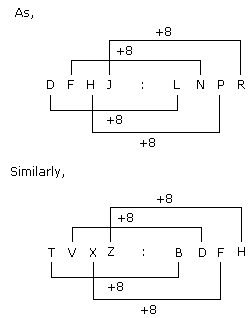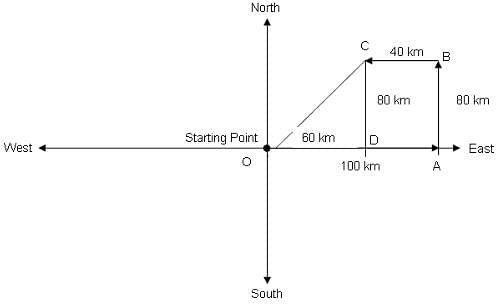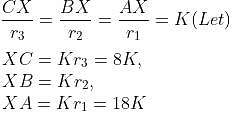CISF Head Constable Mock Test - 7 - CISF Head Constable MCQ
30 Questions MCQ Test CISF Head Constable Mock Test Series 2024 - CISF Head Constable Mock Test - 7
If A + B means A is the brother of B; A – B means A is the sister of B and A x B means A is the father of B. Which of the following means that C is the son of M?
Amazing Chips Ltd., a snacks manufacturing company located in Delhi, as of now sells its products in the Delhi and NCR region only. Since the company had been doing quite well for the last three years, the management is thinking of expanding the business pan India. To ensure that the expansion plan would be profitable, the management decided to undertake a cost benefit analysis.
Which are the factors that the management must consider for their cost-benefit study?
I. Operations and Logistics Cost
II. Marketing Expense
III. Only Local Competition in the new cities
IV. Both Local and National competition
V. Working Capital
VI. New factory
VII. Human Resources
V III . Price
| 1 Crore+ students have signed up on EduRev. Have you? Download the App |
At a mathematics competition, a professor gives a new definition that a number is called 'defector' if it is impossible to factorise the given number. He then calls a number 'super defector' if the number formed by breaking the number into as many possible smaller numbers ( without re-ordering) and all the numbers so formed are defectors. For example, 123 can be broken into 1, 2, 3, 12, 23 and 123. Note that 13, 32, 21, 31 etc. are not involved.
How many 3-digit numbers are 'super defectors'?
Directions to Solve
In each of the following questions find out the alternative which will replace the question mark.
Question -
DFHJ : LNPR :: TVXZ : ?
Rocky drives a car in the east direction and covers 100 km. Then he takes a turn and moves 80 km in the north direction. After that, he takes a left turn and covers 40 km, and reaches his destination. How much distance is he away from the starting position?
Directions: Study the following information carefully and answer the question given below.
Eight people O, H, U, V, I, D, B and G are sitting around a circular table facing the centre.
O is sitting second to the left of U and third to right of H. D and I are immediate neighbors of each other and one of them is an immediate neighbor of O. V is sitting second to the right of B. G is sitting second to the left of D.
Q. Which of the following persons is sitting immediate right of V?
Direction: In each question below is given a statement followed by two conclusions numbered I and II. You have to assume everything in the statement to be true, then consider the two conclusions together and decide which of them logically follows beyond a reasonable doubt from the information given in the statement.
Statements: Recent trends also indicate that the number of child migrants in large cities is increasing. These children leave their families to join the ranks of urban poor doing odd jobs in markets, workshops, hotels or in service sectors.
Conclusions:
- Migration to big cities should be checked.
- The plight of poor children should be thoroughly studied.
Direction: In each question below is given a statement followed by two conclusions numbered I and II. You have to assume everything in the statement to be true, then consider the two conclusions together and decide which of them logically follows beyond a reasonable doubt from the information given in the statement.
Statements: The percentage of the national income shared by the top 10 per cent of households in India is 35.
Conclusions:
- When an economy grows fast, concentration of wealth in certain pockets of population takes place.
- The national income is unevenly distributed in India.
The following line graph gives the ratio of the amounts of imports by a company to the amount of exports from that company over the period from 1995 to 2001.
What was the percentage increase in imports from 1997 to 1998 ?
In what time will Rs. 8000 amount to 40,000 at 4% per annum? (simple interest being reckoned)
A number when divided by 837 leaves a remainder of 79. What will be the remainder when the same number is divided by 31?
The numerator of a rational number is 4 less than the denominator. If the numerator is increased by 15 and denominator is decreased by 4, we get 6. Find the rational number?
60 percent of the employees of a company are women and 75% of the women earn 20000 or more in a month. Total number of employees who earns more than 20000 per month in the company is 60 percent of the total employees.What fraction of men earns less than 20000 per month?
X can do piece of work in 5 days. Y can do it in 10 days. With the help of Z, they finish the work in 2 days. In how many days Z alone can do the whole work?
At present, the average age of a father and his son is 29 years. The average age of father, mother and son five years from now will be 37 years. Find the mother's present age.
A man purchased 10 pens and got 2 pens free. He marked the price 20% more than the CP. He did not allow any discount and sold all the 12 pens for this price. Find his profit percentage.
Three spherical marbles are placed in a hollow inverted cone, one above the other. Each marble is in contact with the adjacent marble(s). Also, each marble is in contact with the wall of the cone. The smallest marble has a radius of 8 cm. The largest marble has a radius of 18 cm.
The radius of the middle marble is
In these days of inflation / a ten rupee's note will not buy you / even an ordinary meal. / No error.
In the following questions four alternatives are given for the idiom/phrase italicised and underlined in the sentence. Choose the alternative which best expresses the meaning of idiom/phrase.
Q. He is out and out a reactionary.
Directions: Rearrange the following six sentences (1), (2), (3), (4), (5) and (6) in the proper sequence to form a meaningful paragraph and then answer the question given below.
1. She put the bag with Jimmy’s belongings on the seat beside her in the car.
2. She carried Jimmy’s belongings, and the plastic bag with the lock of his hair to her son’s room.
3. Sally walked out of Children’s mercy Hospital for the last time, after spending most of the last six months there.
4. It was even harder to enter the empty house.
5. She started placing the model cars and other personal things back in his room exactly where he had always kept them.
6. The drive home was difficult.
Q. Which of following is the FIRST sentence after rearrangement?
Direction: Read the following passage carefully and answer the question that follows.
After a worrying pre-monsoon phase between March and May, when rainfall was scarce, the current robust season in most parts of coastal, western and central India augurs well for the entire economy. Aided apparently by beneficial conditions in the Indian Ocean, very heavy rainfall has been recorded, notably in Maharashtra, Gujarat, Rajasthan, the northeastern States, Karnataka, the Konkan coast, hilly districts of Kerala and Tamil Nadu. This pattern may extend into Chhattisgarh, Odisha, Bengal and other eastern regions. A normal Indian Summer Monsoon is bountiful overall, but as last year’s flooding in Kerala, and the Chennai catastrophe of 2015 showed, there can be a terrible cost in terms of lives and property lost, and people displaced. Distressing scenes of death and destruction are again being witnessed. Even in a rain-shadow region such as Coimbatore in Tamil Nadu, the collapse of a railway parcel office after a downpour has led to avoidable deaths. What this underscores is the need to prepare for the rainy season with harvesting measures, as advocated by the Centre’s Jal Shakti Abhiyan, and a safety audit of structures, particularly those used by the official agencies. In drafting their management plans, States must be aware of the scientific consensus: that future rain spells may be short, often unpredictable and very heavy influenced by a changing climate. They need to invest in reliable infrastructure to mitigate the impact of flooding and avert disasters that could have global consequences in an integrated economy.
The long-term trends for flood impact in India have been one of declining loss of lives and cattle since the decadal high of 1971-80, but rising absolute economic losses, though not as a share of GDP. It is important, therefore, to increase resilience through planning, especially in cities and towns which are expanding steadily. Orderly urban development is critical for sustainability, as the mega flood disasters in Mumbai and Chennai witnessed in this century make clear. It is worth pointing out that the response of State governments to the imperative is tardy and even indifferent. They are hesitant to act against encroachment of lake catchments, river courses and floodplains. The extreme distress in Chennai, for instance, has not persuaded the State government against allowing structures such as a police station being constructed on a lake bed, after reclassification of land. Granting such permissions is an abdication of responsibility and a violation of National Disaster Management Authority Guidelines to prevent urban flooding. As a nation that is set to become the most populous in less than a decade, India must address its crippling cycles of drought and flood with redoubled vigour. Scientific hydrology, coupled with the traditional wisdom of saving water through large innovative structures, will mitigate floods and help communities prosper.
Q. Which among the following is/are correct according to the information given in the passage?
I. The National Disaster Management Authority Guidelines prevent the government to give permission to construct something by changing the nature of the land.
II. Chennai administration is not at all interested in taking preventive measures to control flood in the city.
III. There have been too many encroachments in the river bed areas in various cities across the country.
Direction: Read the following passage carefully and answer the question that follows.
After a worrying pre-monsoon phase between March and May, when rainfall was scarce, the current robust season in most parts of coastal, western and central India augurs well for the entire economy. Aided apparently by beneficial conditions in the Indian Ocean, very heavy rainfall has been recorded, notably in Maharashtra, Gujarat, Rajasthan, the northeastern States, Karnataka, the Konkan coast, hilly districts of Kerala and Tamil Nadu. This pattern may extend into Chhattisgarh, Odisha, Bengal and other eastern regions. A normal Indian Summer Monsoon is bountiful overall, but as last year’s flooding in Kerala, and the Chennai catastrophe of 2015 showed, there can be a terrible cost in terms of lives and property lost, and people displaced. Distressing scenes of death and destruction are again being witnessed. Even in a rain-shadow region such as Coimbatore in Tamil Nadu, the collapse of a railway parcel office after a downpour has led to avoidable deaths. What this underscores is the need to prepare for the rainy season with harvesting measures, as advocated by the Centre’s Jal Shakti Abhiyan, and a safety audit of structures, particularly those used by the official agencies. In drafting their management plans, States must be aware of the scientific consensus: that future rain spells may be short, often unpredictable and very heavy influenced by a changing climate. They need to invest in reliable infrastructure to mitigate the impact of flooding and avert disasters that could have global consequences in an integrated economy.
The long-term trends for flood impact in India have been one of declining loss of lives and cattle since the decadal high of 1971-80, but rising absolute economic losses, though not as a share of GDP. It is important, therefore, to increase resilience through planning, especially in cities and towns which are expanding steadily. Orderly urban development is critical for sustainability, as the mega flood disasters in Mumbai and Chennai witnessed in this century make clear. It is worth pointing out that the response of State governments to the imperative is tardy and even indifferent. They are hesitant to act against encroachment of lake catchments, river courses and floodplains. The extreme distress in Chennai, for instance, has not persuaded the State government against allowing structures such as a police station being constructed on a lake bed, after reclassification of land. Granting such permissions is an abdication of responsibility and a violation of National Disaster Management Authority Guidelines to prevent urban flooding. As a nation that is set to become the most populous in less than a decade, India must address its crippling cycles of drought and flood with redoubled vigour. Scientific hydrology, coupled with the traditional wisdom of saving water through large innovative structures, will mitigate floods and help communities prosper.
Q. Which among the following is correct regarding the impact of flood in India over the years starting from 1970s?
Who was the first Indian batsman to hit a century on Test debut against England at England's home?
Which of the following trends were seen in the Indian economy after the 1991 economic reforms?
1. The growth rate steadily increased.
2. Agriculture and allied sector continuously show a positive growth rate.
3. Share of the public sector in total investment increased.
Which of the statements given above is/are correct?
With reference to the outcomes observed in the decade following the LPG reforms initiated in India in 1991, consider the following statements.
1. It led to rapid increase in FDI and forex reserves.
2. It led to increase in the GDP growth of the Indian economy.
3. It led to lower growth rate in manufacturing industries.
Which of the statements given above is/are correct?
Which Indian state recently inaugurated the Sai Hira Global Convention Centre?



























